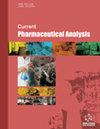振动分光光度法:胃癌和肝癌诊断综述
IF 1.5
4区 医学
Q4 PHARMACOLOGY & PHARMACY
引用次数: 0
摘要
简介:红外光谱和拉曼光谱已成为胃癌和肝癌的有前途的诊断工具,与传统的组织学和基于生物标志物的方法相比具有显著优势。方法:这些光谱技术可提供快速、高度特异性的分子指纹图谱,只需进行最少的样本制备,即可实现实时诊断,并可保存样本以备进一步分析。纳米粒子的集成,特别是在表面增强拉曼光谱中的集成,通过局部表面等离子体共振放大信号强度,提高了该方法的灵敏度和分辨率。这一进步有助于检测与癌症相关的细微分子变化,甚至是早期阶段的变化。研究结果拉曼光谱是一种非破坏性技术,可以区分健康细胞和恶性细胞,有助于诊断各种胃癌,包括腺癌和胃肠道间质瘤。同样,红外光谱技术还能深入了解组织的化学成分,检测与癌症有关的分子变化。对于包括肝细胞癌在内的肝癌,这些光谱方法可揭示生化变化,有助于疾病的早期检测和定性。本综述探讨了拉曼光谱和红外光谱在诊断胃癌和肝癌中的应用,强调了它们通过识别与恶性肿瘤相关的分子变化来提高诊断准确性和改善患者预后的潜力。结论总之,将纳米粒子与光谱技术相结合,在提高癌症诊断的准确性、速度和有效性方面具有巨大潜力。本文章由计算机程序翻译,如有差异,请以英文原文为准。
Vibrational Spectrophotometry: A Comprehensive Review on the Diagnosis of Gastric and Liver Cancer
Introduction: Infrared and Raman spectroscopy have emerged as promising diagnostic tools for gastric and liver cancer, offering significant advantages over traditional histology and biomarker- based methods. Methods: These spectroscopic techniques provide rapid and highly specific molecular fingerprinting with minimal sample preparation, enabling real-time diagnosis and preserving samples for further analysis. The integration of nanoparticles, particularly in surface-enhanced Raman spectroscopy, enhances the sensitivity and resolution of the method by amplifying signal strengths through localized surface plasmon resonances. This advancement facilitates the detection of subtle molecular changes associated with cancer, even at early stages. Results: Raman spectroscopy, a non-destructive technique, can differentiate between healthy and malignant cells, aiding in the diagnosis of various gastric cancer forms, including adenocarcinoma and gastrointestinal stromal tumors. Similarly, IR spectroscopy provides insights into the chemical composition of tissues, detecting molecular changes associated with cancer. For liver cancer, including hepatocellular carcinoma, these spectroscopic methods reveal biochemical alterations, facilitating early detection and characterization of the disease. This review explores the application of Raman and IR spectroscopy in diagnosing gastric and liver cancers, emphasizing their potential to enhance diagnostic accuracy and improve patient outcomes by identifying molecular changes linked to malignancies. Conclusion: Overall, the integration of nanoparticles into spectroscopic techniques holds significant potential for improving the accuracy, speed, and efficacy of cancer diagnostics.
求助全文
通过发布文献求助,成功后即可免费获取论文全文。
去求助
来源期刊
CiteScore
1.50
自引率
0.00%
发文量
85
审稿时长
3 months
期刊介绍:
Aims & Scope
Current Pharmaceutical Analysis publishes expert reviews and original research articles on all the most recent advances in pharmaceutical and biomedical analysis. All aspects of the field are represented including drug analysis, analytical methodology and instrumentation. The journal is essential to all involved in pharmaceutical, biochemical and clinical analysis.

 求助内容:
求助内容: 应助结果提醒方式:
应助结果提醒方式:


